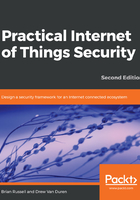
Autonomous systems
The IoT connectivity layer is starting to enable the introduction of pervasive autonomy. We are already seeing how this works in the consumer space, with integrations between vehicles and smart homes as an example. New research in both academia and industry are pushing autonomous systems and capabilities even further. Swarms of drones can work together with no human intervention. Machines can independently process and settle transactions between each other. Self-Driving Vehicles (SDVs) can form platoons that coordinate among themselves on the road. These are just a few examples of the coming age of autonomy.
Different types of autonomous vehicles (cars, drones, ships, and so on) take input from distributed sensors that might include cameras, LIDAR, RADAR, Global Positioning System (GPS), and even intertial measurements. These inputs are transmitted to fusion systems and then processed through navigation, guidance, and mission subsystems, which are integrated with propulsion and other platform sub-systems. Autonomy algorithms that might be employed in a system such as this include sense and avoid, pattern detection, object identifications, vector determination, and collision predictions.
Machine Learning (ML) is used heavily within autonomous systems. ML algorithms learn over time by training on large datasets. A critical research area for IoT ML is associated with the use of adversarial examples that can train systems to identify malicious inputs into the algorithms. For example, research has shown that it is possible to slightly alter images to fool ML models into thinking that something is not what it really is. Injecting adversarial examples into the ML process can help prepare algorithms to identify and react to attempted abuse.